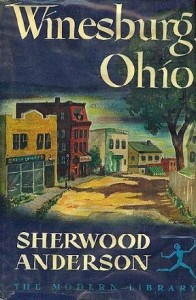 Anderson, Sherwood. Winesburg, Ohio
Anderson, Sherwood. Winesburg, Ohio
Original publication date: 1919
Rpt. New York: Random House, 1947
Sherwood Anderson’s masterpiece, Winesburg, Ohio, is a collection of 23 interrelated sketches—Anderson calls them “tales”—that portray life in a Midwestern town in the early years of the twentieth century. The unifying thread throughout is the coming-of-age story of George Willard, an 18-year-old news reporter who dreams of leaving the confines of his home town and making his way in the larger world as a writer.
The book is significant historically for its use of common speech to portray its characters, the common people of Winesburg. Stylistically, Anderson influenced Ernest Hemingway and William Faulkner.
The book is also significant historically for its place in the development of American realism and naturalism. Realism, which developed in France in the second half of the nineteenth century, emphasized the influence of social environment on characters. As realism developed, it shifted into naturalism, with an emphasis on impersonal social, economic, and biological forces on individuals. With its focus on the psychological and biological impulses of its characters, Anderson’s book illustrates the beginning of this shift. Here, for example, is the narrator’s description of Kate Swift in “The Teacher”:
Day by day as she worked in the schoolroom or walked in the streets, grief, hope, and desire fought within her. Behind a cold exterior the most extraordinary events transpired in her mind. (p. 191)
Most of the tales recount characters who have internal hungers and desires—ranging from pedophilia and God’s approval to fame, wealth, and human companionship—that they struggle to submerge in the belief that no one else harbors such secrets. For example, in “Queer” Elmer Cowley, unable to make friends after moving to Winesburg, feels that he’s always strange or abnormal, somehow different from other people:
George Willard, he felt, belonged to the town, typified the town, represented in his person the spirit of thee town. Elmer Cowley could not have believed that George Willard had also his days of unhappiness, that vague hungers and secret unnamable desires visited also his mind. (p. 234)
Anderson’s use of such subject matter is more subdued than other authors of the same time period such as Theodore Dreiser and Frank Norris.
Winesburg, Ohio opens with “The Book of the Grotesque,” which defines the term grotesque. In the beginning, when the world was young, there were a great many thoughts but no such thing as a truth. “Man made the truths himself and each truth was a composite of a great many vague thoughts” (p. 4). All these truths were beautiful. Then people came along and snatched up the truths. “It was the truths that made the people grotesques… . The moment one of the people took one of the truths to himself, called it his truth, and tried to live his life by it, he became a grotesque and the truth he embraced became a falsehood” (p. 5).
In this tale an old writer contemplates “something inside him [that] was altogether young” (p. 2). “He imagined the young indescribable thing within himself was driving a long procession of figures before his eyes… . They were all grotesques” (p. 3). The old writer wrote a book about the grotesques but never published it. “It was the young thing inside him that saved the old man” (p. 5).
“Sophistication,” the second-to-last story in the collection, describes George Willard’s coming of age in similar terms:
In youth there are always two forces fighting in people. The warm unthinking little animal struggles against the thing that reflects and remembers, and the older, the more sophisticated thing had possession of George Willard. (p. 294)
Earlier, in “The Teacher,” Kate Swift, who had once been George Willard’s teacher, tries to explain to George “the difficulties he would have to face as a writer”:
“If you are to become a writer you’ll have to stop fooling with words … You must not become a mere peddler of words. The thing to learn is to know what people are thinking about, not what they say” (p. 192)
Like the old writer whose tale opens the book, George must grow up while at the same time keeping the young thing inside him alive. To become a writer, he must learn to look beneath the surface of what people say to understand their inner thoughts and desires.
The tales throughout this book tell stories of human desires thwarted and human connections unrealized. The last thing that George Willard must learn as he leaves Winesburg to embark on his life as a writer is how to exist in such a world. In “Sophistication” George meets up with Helen White, a young woman he feels attracted to:
George Willard sat beside Helen White and felt very keenly his own insignificance in the scheme of existence… . the two oddly sensitive human atoms held each other tightly and waited. In the mind of each was the same thought. “I have come to this lonely place and here is this other,” was the substance of the thing felt. (pp. 295–296)
© 2015 by Mary Daniels Brown

